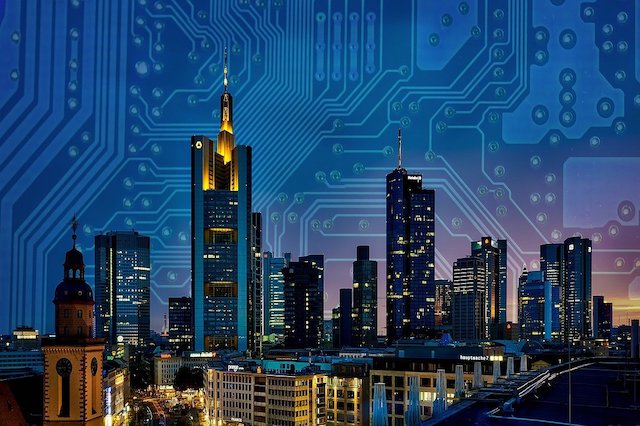
What are Robots?
Robotics is the field of science that studies the design, building, operation, and application of robots.
The word robot comes from a Slavic word meaning "worker."
The first known use in print of the term "robotics" was in 1923 by author Karel Čapek in his play R.U.R., which stood for "Rossum's Universal Robots." Today, the definition has expanded to be defined as the theory and practice of constructing machines that can substitute for human sensibility and act on our behalf.
A robot is essentially just any machine that is capable of executing one or more tasks automatically or with remote control (such as via electronic programming). They are designed primarily to take over the jobs that are too dangerous or monotonous for humans to do. Robots can range in size from microscopic nano-machines to huge trucks and cranes and can be made up of biological and artificial components. If you've ever seen a Roomba vacuum cleaner, an automated machine tool, or an automobile assembly line (just to name a few), then you've witnessed different types of robots at work.
There is no one accepted standard for what comprises a robot; however, some characteristics define many robots. They tend to be "multi-articulated," which means that they have six or more joints that allow them to move easily through their environment by reconfiguring the shape and orientation of their bodies. They can also usually sense things about their environment and are able to respond accordingly. A robot's programming tells it what actions to take in response to its sensors' information, such as moving away from an object if it detects a collision is imminent.
The area of robotics deals with the design, construction, operation, and application of robots; this includes robotic devices and multi-functional robots (electrical or mechanical machines or virtual software agents) that can substitute for humans (e.g., smart appliances and machine tools).
Types Of Robots
Though there are many different types of robots, three broad categories can be identified:
1) Mobile robotics - are wheeled or have legs and move around the environment to perform a task. They are used mainly for surveillance or inspecting places that are difficult to reach or hazardous. For example, they may work with firefighters on the scene to explore an unstable building so that humans will not suffer the same fate if it collapses.
2) Industrial robotics - are fixed machines attached to automated guided vehicles, automated assembly lines, etc., where they transport parts from one location to another based on programmed instructions (e.g., receiving component sub-assemblies and stacking them in the correct location for installation).
3) Service robots - which are non-industrial robots that perform tasks for people, such as vacuum cleaners, floor washing machines, lawnmowers, and other domestic robots.
Manipulative robotics takes care of the methods by which a robot might physically interact with the world, such as grasping an object or walking up the stairs. Cognitive Robotics is when information about its environment needs to be integrated so it can make decisions. And social robotics is where efficient interaction between machines and humans is required (e.g., a robot that accompanies a person to the doctor's office and helps them through what could otherwise be a confusing experience).
In this way, robots can incorporate both hardware and software to allow them to perform multiple tasks in different environments. The biggest challenge with robotics is for it to fulfill all of our expectations about an automated system without encountering too many problems along the way.
Advantages and disadvantages of robots
One of the many questions that humans have been asking themselves about robots is whether they will be beneficial to society or not. This is a difficult question, and there are both advantages and disadvantages.
Advantages:
Robots would help with jobs that humans cannot do because of health problems (too heavy, too much smog), life expectancy (ex: very far away space), or otherwise inaccessible places (too hot/cold, can't get in). Robots will also make jobs easier and more accessible for humans who might need breaks during work - for example, long shifts at work. This includes people like nurses and doctors who often need to take breaks but still want to help other patients. It's especially important that we don't lose jobs just because the job is too hard on a human's body, and robots will help us stay in business.
Another thing that robots could do for humans is teach them. This can be anything from teaching children to drive to teaching adults how to fix machines, like cars. They could also help an aging population with day-to-day tasks such as grocery shopping and cooking.
A robot's most important advantage is its ability to work around the clock and not get tired or sick. This means humans won't have to hire more employees who cannot work long hours, often win out over younger employees who want more flexible schedules (for example, high schoolers), and they won't have to pay for things like medical benefits or vacation time.
Disadvantages:
One disadvantage is that robots are not currently able to think for themselves, which means they must be programmed. This means that they will not be able to adapt to different situations on the fly, making them less flexible than humans in some ways. If a robot is programmed to do one thing and something changes, it will need an entirely new program before it can adapt again. Also, if the programming is complex or takes too much time upfront, businesses may lose out on profit or money altogether. They would have to hire more people just to get the robots programmed so they could work independently - this would actually put some workers out of business due to a lack of profit. Robots are also still very expensive, costing thousands of dollars each.
Another problem with robots is that they are too accurate at the expense of any workers around them. For this reason, some jobs cannot be done by robots yet. They can't make quick judgments about who to shoot or where to send bombs. Robots may also present a danger to humans if something goes wrong - for example, they fall on someone walking by.
What is the future of robotics? Will robots take over the world?
As technology becomes more and more a part of our lives, we must ask ourselves where the line is drawn between a machine and a living being. At what point do robots become people? And when that happens, will they be able to take over the world like some Hollywood movies depict them doing?
The first question one might ask themselves is, why would robots want to take over the world at all? What purpose would it serve for them to try and rid us, humans, from this planet? Many scientists feel that robots are simply too different from human beings for this to ever be possible. According to Jeffrey A. Freidberg, Dean of Engineering at Tufts University in Medford, Massachusetts, "A robot has no strong drive; it doesn't have a human being's need to achieve, to accomplish something. It doesn't have a life of its own that it needs to preserve because it isn't a living organism".
With that said, there is still the possibility that one-day robots could be built with the ability to feel emotion and therefore have an interest in killing us off. But what purpose would this serve for them? What reason could there be for them wanting our extinction? If anything, robots might simply deem humans as useless and therefore get rid of us so they can live out their lives without having to bother with us anymore. Either way, if we were ever going to see a robot uprising come true, the first step would involve machines accomplishing tasks more efficiently than humans can.
This is already happening with the invention of driverless cars that drive more safely than humans do. But how long will it be before robots are able to accomplish tasks in a way humans can't even imagine? And what type of tasks will this involve? Building structures, developing vaccines, creating electronic devices The possibilities are endless!
There are still things we don't fully understand about our brains and how they work. How is it possible for us to remember things when we were only babies? Why does learning certain concepts sometimes feel like an impossible task while other times it seems easier than pie? There are so many mysteries in our own bodies that scientists have yet to solve. Could robots ever accomplish these types of tasks based on what they learn from us?
A robot might not be able to make these types of mental connections the way we humans can, but it might be possible for them to learn by observation. A home-cleaning robot could potentially watch a housekeeper cleaning up around the house and then maybe try doing some cleaning on its own when nobody is around. Of course, not all tasks are so easy. However, robots are starting to become increasingly human-like in their abilities.
According to one estimate, the number of robots worldwide could reach 20 million by 2030, with automated workers taking up to 51 million jobs in the following decade. While they may not take over the planet, we can expect to see more robots in our everyday environment.
What impact will robots have on the world?
That's the question many people are asking themselves in this day and age. Ray Kurzweil, an American computer scientist, author, inventor, futurist, and director of engineering at Google, has made projections showing that by 2029 machines will have human-level intelligence. This implies that robots may take over many jobs which are currently done by humans.
But why are robots taking over these jobs? "Robots have become cheaper while simultaneously becoming more efficient," says Tim Urban of Wait But Why. When companies move their production to another country where labor is cheap, they no longer need to hire so many employees since it costs less to employ a robot than it does to hire human beings. Examples include car manufacturers moving their factories from Germany or the United States to Mexico in order to benefit from the cheaper labor. Amazon is currently testing their Amazon Go store, which uses machine learning and sensors to automatically charge customers for products they walk out of the store with, replacing cashiers entirely. Of course, these jobs are only replaced because it costs less than hiring someone else to do them.
Other companies are coming up with machines that can perform highly accurate tasks better than humans would be able to do. For example, ABB Robotics has created a robot called YuMi which can simultaneously manipulate objects with great precision while exerting very little pressure on them thanks to its two arms that mimic the movements of human arms. It could be possible that robots will replace many highly skilled manual jobs.
What's next?
Although robots may take over many jobs, it is also possible that there will be new jobs created as a result of these advances in robotics. For example, Baxter, an industrial robot without arms that was launched by Rethink Robotics, requires no programming and can easily be taught to perform various tasks thanks to its easy-to-use touchscreen. In the future, we could see more people becoming robot technicians or engineers. We currently still have no idea what direction technology will go. However it is likely that robots will become a part of our lives whether we want them to or not.






